|
1. Thymelicus lineola (Ochsenheimer, 1806) / Essex skipper / Hesperiidae – Hesperiinae
NL: zwartsprietdikkopje / D: Schwartzkolbiger Dickkopffalter / F: hespérie du dactyle, le ligné
.jpg) .jpg) 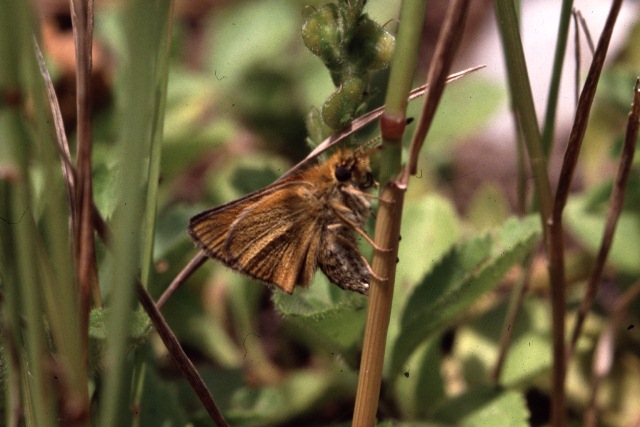
Photographs: Frits Bink ©.
Very small, wing length 13 (12-14) mm. Throughout the Benelux a common and wide spread species that occurs in saltmarshes, dunes, heathland, grasslands and in the countryside on roadside verges, railway banks, wood edges, abandoned hayfield and lightly grazed meadows. The butterfly prefers tall grass vegetation and is sometimes accompanied by Thymelicus sylvestris where they imbibe together on flowering plants like thistle.
Butterfly is on the wing from mid-June until mid-August and peaks mid-July. It occurs in maritime and severe continental climate, amplitude range from 6 to 20. Required heat sum is 580°d, the maximum tolerated 2000°d, the corresponding climate windows are 22 and 38 weeks.
The species appeared in America in 1910, first in Ontario, probably introduced by importing hay from Europe and became a pest on timothy grass (Phleum pratense) in hayfields. It then spread with a speed of 25 km per year and reached British Columbia in 1960 (Scott 1986: 433). Probably because of its hibernation stage as egg it was able to spread so quickly by the transport of hay.
The presence of undisturbed tall grass during overwintering is an important feature of its habitat.
Ecological characteristics
Behaviour over time
Overwintering: in a cluster of 5-15 eggs inside a folded withered leaf.
Reproduction: starts oviposition after a week when the body contains 58 (43-70) eggs, potential egg production up to 2.8 times more.
Larval feeding periods: 9 weeks from early April till the end of June.
Generations: always one.
Spreading of risk: a small proportion of the population will disperse.
Life cycle: egg 36-40 weeks; larva 60 (50-71) days; pupa 16 (14-20) days.
Life span of adult: long, 4 weeks.
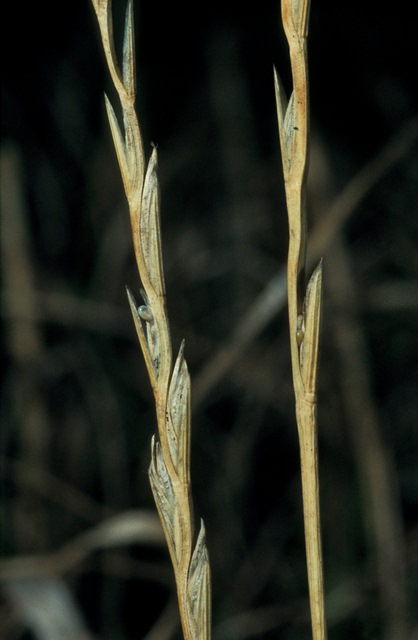 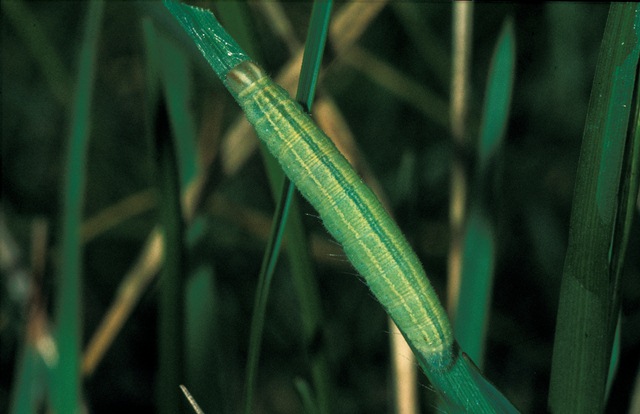
Photographs: Frits Bink ©.
Behaviour in space
From stay-at-home to migrant: stay-at-home, spatial requirement very modest, some individuals will migrate over several kilometres.
Finding a mate: male perches, also the sexes meet each other on a flowering plants e.g. a thistle or a knapweed.
Orientation in the landscape: edges between tall and low grass, in large and open fields in a mosaic pattern in the grass vegetation.
Oviposition: careful selection on old grass vegetation of a withered leaf where the female put her eggs into the sheath at the junction of leaf and stem. The female uses her wedge like ovipositor to get access into the sheath, a typical feature of all Thymelicus species.
Defence
Threats from other organisms: larva lives most of its life safely hidden inside a tube of enrolled leaf.
Threats from the environment: freshly hatched larva vulnerable to adverse weather, adult rather tolerant to heat and drought in summer.
Feeding habits
Adult: nectar, the butterfly can use flowers with deep nectar, length of proboscis 13.5-14.5 mm.
Larva: in spring the larvae feed on very young shoots, later in the season on parts of its tubes of enrolled broad leaves and finally free living on grass blades.
Larval foodplants
Plant species: Poaceae, tall grasses as Alopecurus pratensis, Brachypodium pinnatum, Calamagrostis epigejos, Dactylus glomerata, Elymus repens, Festuca pratensis, Holcus lanatus, Lolium perenne, Phleum pratense, Poa pratensis.
Journal
Rearing experiments based on specimens from Veenendaal, Netherlands:
7 July 1983: 3 females captured.
10 July: 70 eggs laid on old flower spike of Lolium perenne.
28 August: no larvae were seen inside the eggs.
No larvae seen in spring following overwintering indoors.
25 May 1984: larvae collected at the same locality on the grass Elymus repens. Four larvae were 7 mm in size, seven 9-14 mm, one in moult L4-5, 14 mm. The small larvae were inside a rolled up blade, the bigger ones already free living on the grass blades.
8 June: first pupa.
22 June: first butterfly.
1 August: there were many skippers at the collection site. Three of them collected for egg counts; observed egg loads 20, 32 and 35.
Table 1-1. Results of dissections

Table 1-2. Collection and observation localities
D, Lorch 300m, 50° 02’ 05”N – 7° 47’ 56”E; 31 July 1985.
DK, Tofte Mose 56° 49’ 16”N – 10° 16’ 08”E; 4 July 2005.
EST, Kuresoo, 58° 28’ 00”N – 25° 11’ 59”E; 8 July 1999.
EST, Viruna 58° 28’ 51”N – 23° 58’ 32”E; 5 July 1999.
EST, Endla Nature Reserve, 58° 52’ 34”N – 26° 16’ 21”E; 10 July 1999.
EST, Pööravere 58° 40’ 25”N – 24° 36’ 50”E; 16 July 1999.
F, Lorraine, Jaulny 209 m, 48° 57’ 55”N – 5° 52’ 52”E; 29 June 2002, 8 July 2006.
F, Vosges, Hohneck 1283 m, 48° 02’ 03”N – 7° 02’ 27”E; 22 August 1984.
F, Pagny-la-Blanche-Côte, 308 m, 48° 32’ 37”N – 5° 42’ 58’’E; 10 July 1985, 5 July 2006.
F, Pagny-la-Blanche-Côte, 322 m, 48° 32’ 01”N – 5° 44’ 14”E; 7 July 2006.
NL, Dintelse Gorzen 51° 37’ 57”N – 4° 15’ 39”E; 22 August 2000.
NL, Hoge Veluwe 52° 05’N – 5° 51’E; 11 July 1983, 30 July 1984.
NL, Hoge Veluwe 52° 04’ 47”N – 5° 49’ 47”E; 27 July 2000, 31 August 2000.
NL, Slikken van de Heen 51° 37’ 23”N – 4° 11’ 54”E; 23 August 2000.
NL, Veenendaal 52° 01’ 51”N – 5° 31’ 17”E; 7 July 1983, 25 May 1984 larvae, 1 August 1984 adults.
NL, Wageningen, Eng, 51° 58’ 47”N – 5° 41’ 09”E; 6 July 2014.
S, Gotland, Grogarns 57° 25’ 32”N – 18° 53’ 21”E; 14 July 2004.
S, Gotland, Klinteklinten 57° 40’ 14”N – 18° 46’ 26”E; 13 July 2004.
S, Gotland, Lickershamn 57° 51’ 05”N – 18° 37’ 46”E; 17 July 2004.
S, Gotland, Mallgård Källmyr 57° 19’ 32”N – 18° 17’ 14”E; 20 July 2004.
S, Gotland, Russväter 57° 23’ 29”N – 18° 43’ 36”E, 21 June 2004, 16 July 2004.
S, Gotland, Stygmyr 57° 50’ 10”N – 18° 38’ 32”E; 18 July 2004.
S, Öland, Stenåsa 56° 32’ 44”N – 16° 36’ 43”E; 21 July 2004.
Fig. 1-1. Thymelicus lineola, phenogram adapted from Fichefet et al. 2008: 59.
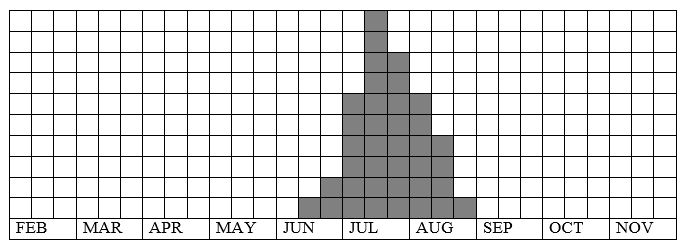
Fig. 1-2. Thymelicus lineola, habitat characteristics.
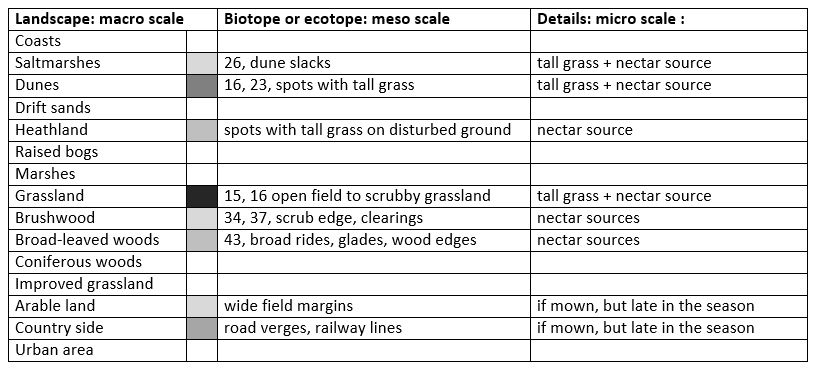
Fig. 1-3. Thymelicus lineola, climate matrix, heat-sums 550 - 2000°d.
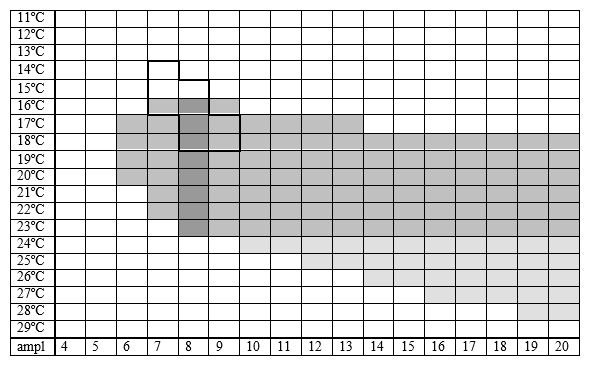
|


.jpg)
.jpg)






